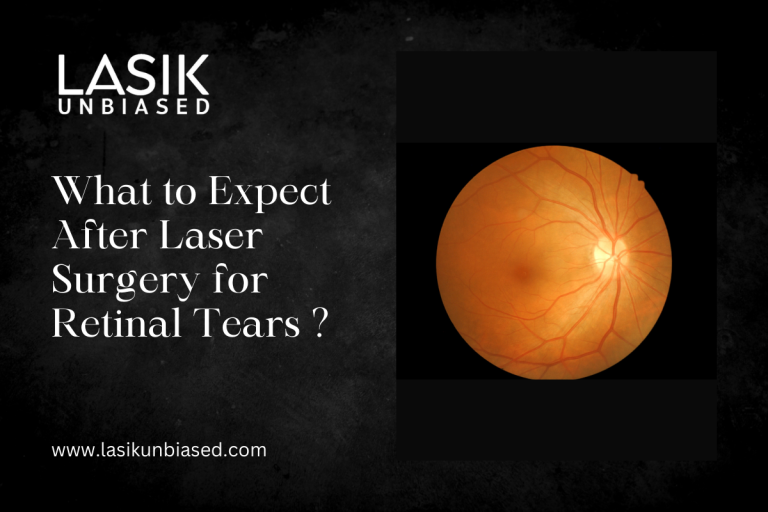Laser surgery for retinal tears is a standard and effective treatment for preventing retinal detachment, which can lead to permanent vision loss. The procedure uses focused laser light to seal retinal tears or holes, promoting healing and preventing fluid from leaking behind the retina. After undergoing laser surgery for retinal tears, it is essential to understand what to expect during the recovery process. This article will guide you through the typical post-surgery experience, helping you to know what to look out for as you heal.
Immediate Aftercare
Immediately after laser surgery for retinal tears, you may experience some discomfort in your eye, including mild irritation or a sensation of fullness. Some patients report feeling something in their eye, but it typically resolves as the eye adjusts to the procedure. You may also notice slight blurring of vision or some floaters in your field of vision for a few days following the surgery. These symptoms are generally temporary and should improve as your eye heals.
Your ophthalmologist will provide specific aftercare instructions, likely including using prescribed eye drops to reduce inflammation or prevent infection. It is crucial to follow these instructions carefully to ensure proper healing and reduce the risk of complications. In the days following the surgery, you may also be advised to avoid rubbing your eyes or engaging in strenuous activities that could put pressure on your eye.
Vision Changes After Surgery
In the days and weeks after the laser surgery, it is common to experience fluctuations in your vision. This can include periods of blurry vision or seeing floaters, which are tiny spots or lines that may appear in your field of vision. These floaters are typically caused by changes in the vitreous gel inside the eye, which can occur after laser treatment. While the floaters can be bothersome, they diminish over time and do not cause permanent visual impairment.
Your vision may also be affected by the healing process of the treated retina. The laser creates minor burns to form scar tissue around the retinal tear; the retina can temporarily change shape during this healing phase. As your eye heals, vision should gradually stabilize, and any blurry or distorted vision will improve. However, monitoring your vision for any sudden or significant changes is essential, as this could indicate a complication requiring prompt attention.
Recovery Timeline
The recovery timeline after laser surgery for retinal tears varies from patient to patient. For most people, the initial healing period is relatively quick. The discomfort should subside within a few days to a week, and you may start to notice improved vision. However, it is essential to avoid activities that could strain the eye, such as lifting heavy objects, strenuous exercise, or any activity that increases pressure inside the eye, for several weeks after the procedure.
During the recovery process, your ophthalmologist will schedule follow-up appointments to monitor the healing of your retina. These check-ups are crucial for ensuring that the tear is adequately sealed and that no further complications, such as new tears or detachment, occur. Depending on the severity of the retinal tear and your healing progress, you may need several visits over the next few months.
Potential Risks and Complications
Although laser surgery for retinal tears is generally safe and effective, there are potential risks and complications to be aware of. Sometimes, the retinal tear may not be fully sealed, or the laser treatment may not effectively prevent retinal detachment. To address the issue, further intervention, such as additional laser treatments or even surgery, could be required.
Other possible complications include infection, bleeding, or swelling inside the eye. In rare cases, the laser treatment can cause the retina to become more detached, leading to further vision problems. It is essential to attend all follow-up appointments and contact your ophthalmologist immediately if you experience sudden vision changes, increased floaters, flashes of light, or pain in the eye, as these could be signs of complications that require prompt treatment.
Long-Term Outlook
In most cases, laser surgery for retinal tears is highly successful in preventing retinal detachment and preserving vision. Once the retina has healed and the tear has been sealed, there is a significantly lower risk of further complications. However, it is essential to continue monitoring your eye health with regular check-ups, as you may still be at risk for other retinal issues, such as new tears or age-related macular degeneration.
Over time, your vision should stabilize and improve, with most patients experiencing minimal long-term effects from the surgery. Any floaters or visual disturbances should gradually decrease, and the eye’s healing process will allow you to return to normal activities. To reduce the risk of future retinal problems, it is essential to maintain a healthy lifestyle and protect your eyes from injury.
Laser surgery for retinal tears is a highly effective treatment to prevent more serious conditions like retinal detachment. While the recovery process may involve temporary discomfort and changes in vision, the procedure is generally safe, with a low risk of complications. Following your ophthalmologist’s aftercare instructions, attending follow-up appointments, and monitoring your vision can ensure a smooth recovery and protect your long-term eye health. If you experience any sudden changes in vision or discomfort, seeking medical attention promptly to address any potential complications is crucial.


